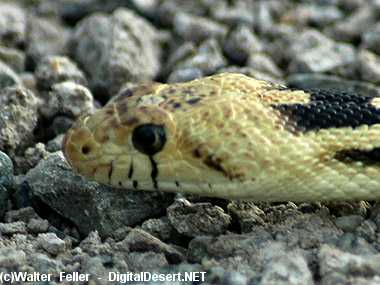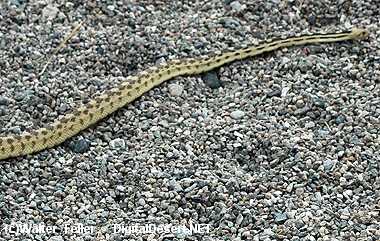Gopher Snake
Pituophis cateniferSUMMARY
This gentle and easy-going snake can be found throughout Mojave Desert. Itís pattern is similar to a rattlesnake and is often mistaken as one and unfortunately killed. It may be yellowish or cream colored and have brown or reddish blotches along the back. It is a very large and powerful snake and occasionally reaches 6 feet in length. Females lay up to 15 eggs in loose sand in April/May with young being born at about 8 inches. It lives over much of the desert in rocks, sandy washes and is a skilled climber. Its prey consists of rodents, rabbits and lizards and it kills its prey by constriction. This snake is very gentle and normally easy to handle.
Gopher Snake Pituophis catenifer
Family: Colubridae Order: Squamata Class: Reptilia
DISTRIBUTION, ABUNDANCE, AND SEASONALITY
The gopher snake is California's most widespread and common snake. Gopher snakes
are found thoughout California, including the Channel Islands, and are absent only from the
high mountains of the Sierra Nevada. They are found in all habitats and are generally absent
only from densely forested habitat stages in the Sierra Nevada. Elevation range extends up
to 2740 m (9000 ft) (Stebbins 1985).
SPECIFIC HABITAT REQUIREMENTS
Feeding: Adults take chiefly mammals and birds while foraging in mammal burrows,
on the ground, or in shrubs. Stebbins (1954) listed mice, kangaroo rats, gophers, ground
squirrels, rabbits, quail and ducks and their eggs as among the food items reported for
gopher snakes. Juveniles take young mice and small lizards. Prey is killed by constriction.
Cover: When inactive, gopher snakes seek cover in rodent burrows and under surface
objects such as flat rocks, logs, and boards. At high elevations with long cold winters,
individuals hibernate, often with other species of snakes, in rodent burrows and in deep
rock fissures.
Reproduction: Eggs are normally laid below the surface in stable rock talus, in
abandoned mammal burrows, and in loose moist soil.
Water: No information on water requirements. Gopher snakes are common in arid
and semi-arid regions. Standing water is not an important habitat element.
Pattern: Prefer sparse and open grassy stages, less common or absent from denser
forested habitat.
SPECIES LIFE HISTORY
Activity Patterns: Gopher snakes may be active on the surface whenever temperatures
are favorable. During the cooler periods of spring and fall most activity occurs mid-day, but
when summer days are hot most activity is restricted to early morning and late evening hours.
Seasonal Movements/Migration: Predictable seasonal movements have not been reported
for ths species in California. In Utah, however, gopher snakes make annual movements to
and from known hibernacula (Parker and Brown 1973). It is probable that this also occurs at
inland montane localities in California. Over much of the rest of their range in California, gopher
snakes spend periods of winter inactivity in or near the areas of their warm-season activity.
Home Range: The nature of the home range of California gopher snakes is not well known.
In southern Idaho, Diller (1981) estimated gopher snake density at 1.3 snakes per ha (.52/ac).
Territory: The nature of territoriality in this species is unknown. "Combat" between males
has been observed during the breeding season, sometimes in the presence of females (Hansen
1950, Shaw 1951).
Reproduction: Clutch sizes range from 3 to 18 and average about 7 or 8. Eggs are
deposited in June and July after the courtship period, which extends from March to May.
Communal nesting has been reported (Brodie et al. 1969). Hatchlings emerge in the fall and
may not feed until the next spring.
Niche: Because of their activity patterns and abundance, gopher snakes are taken
by a wide range of predators including mammals, predatory birds, especially hawks, and
other snakes. The nature of the competitive interactions with other species of snakes is
unknown. It has been suggested that the behaviors and color pattern of gopher snakes mimic
those of rattlesnakes (Gordon 1939, Kardong 1980).
Source:
CDFW California Wildlife Habitat Relationships. Accessed [N/A]
https://wildlife.ca.gov/Data/CWHR

Gopher Snake

Gopher Snake